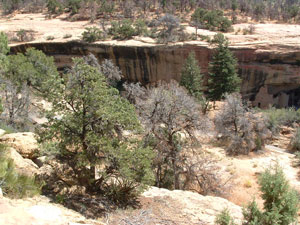Earlier in the week I mentioned drought at Mesa Verde. Now that we’re back and I’ve had time to collect my thoughts and do more research, there’s a bit more to say.

This is my best attempt (sorry, I’m not much of a photographer) to capture the piñon dieoff that we saw. This picture is overlooking Spruce Tree House (you can see a bit of the cliff dwelling in the shadoes on the right).
The dead trees are a function of drought. Bark beetles do the killing, but they prey on stressed trees, which don’t have enough sap to repel them. All over Mesa Verde, fire has been widespread over the last five years, which is also a function of drought. What forest hadn’t burned was dotted with dead trees. This might sound depressing – and might explain the fact that there seemed to be far fewer visitors this year than we remembered in years past. But to me, as a student of drought phenomena, it was fascinating.
Here are some numbers for Mesa Verde:
Average annual precip, 1948 – present: 17.81 inches
Average annual precip, 1991-1998 (the years we became accustomed to things there): 20.3 inches
Average annuual precip, 1999-2003: 13.35 [1]
In other words, precip at Mesa Verde over the last five years is just 75 percent of average, and just 66 percent of what we’d come to expect as normal based on the years we’ve been going there. This is beyond merely the odd stochastic dry year. This is cumulative, five straight dry years.
Given my traditional definition of drought as being “less rain than you’ve come to expect,” or, more precisely for people actually impacted by the drought rather than those like me who just watch it, “less rain than you’ve come to rely on,” you can see why Mesa Verde looks and acts pretty damn dry to us right now.
[1] Thanks once again to the fine folks at the Western Regional Climate Center for their amazing work making data sets available to the public.
